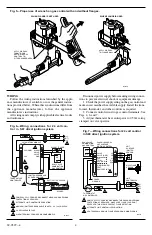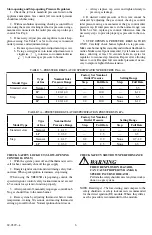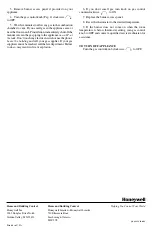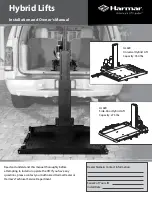
3
69-0329—4
LOCATION
The combination gas control is mounted in the appli-
ance vestibule on the gas manifold. If this is a replacement
application, mount the gas control in the same location as
the old control.
Locate the combination gas control where it cannot be
affected by steam cleaning, high humidity, or dripping
water, corrosive chemicals, dust or grease accumulation or
excessive heat. To assure proper operation, follow these
guidelines:
• Locate gas control in a well-ventilated area.
• Mount gas control high enough above the cabinet
bottom to avoid exposure to flooding or splashing
water.
• Assure the ambient temperature does not exceed the
ambient temperature ratings for each component.
• Cover gas control if appliance is cleaned with water,
steam, or chemicals or to avoid dust and grease
accumulation.
• Avoid locating gas control where exposure to corro-
sive chemical fumes or dripping water are likely.
Install Piping to Gas Control
All piping must comply with local codes and ordinances
or with the National Fuel Gas code (ANSI Z223.1 NFPA
No. 54), whichever applies. Tubing installation must com-
ply with approved standards and practices.
1. Use new, properly reamed pipe free from chips. If
tubing is used, assure the ends are square, deburred and
clean. All tubing bends must be smooth and without defor-
mation.
2. Run pipe or tubing to the control. If tubing is used,
obtain a tube-to-pipe coupling to connect the tubing to the
control.
3. Install sediment trap in the supply line to the gas
control. See Fig. 2.
Install Control
1. This control can be mounted 0-90 degrees, in any
direction, from the upright position of the gas control knob,
including vertically.
2. Mount the control so gas flow is in the direction of
the arrow on the bottom of the control.
3. Thread pipe into control. Do not thread pipe to far.
Valve distortion or malfunction may result if the pipe is
inserted too deeply, refer to Table 4.
TABLE 4—NPT PIPE THREAD LENGTH IN in.
OUTLET
PRESSURE
TAP
INLET
OUTLET
WIRING
TERMINALS (2)
INLET
PRESSURE TAP
PRESSURE REGULATOR
ADJUSTMENT (UNDER
CAP SCREW)
GAS CONTROL KNOB
M3094B
Fig. 4—Top view of gas control.
TWO IMPERFECT
THREADS
GAS CONTROL
THREAD PIPE THE AMOUNT
SHOWN IN TABLE 4 FOR
INSERTION INTO GAS CONTROL
APPLY A MODERATE AMOUNT OF
PIPE COMPOUND TO PIPE ONLY
(LEAVE TWO END THREADS BARE).
M3075A
PIPE
4. Apply a moderate amount of good quality pipe com-
pound (do not use Teflon tape) to pipe only, leaving two
end threads bare. On LP installations, use compound resis-
tant to LP gas. See Fig. 3.
5. Remove seals over control inlet and outlet if neces-
sary.
6. Connect pipe to control inlet and outlet. Use wrench
on the square ends of the control. If a flange is used, place
wrench on flange rather than control. Refer to Figs. 4 and 5.
Fig. 2—Sediment trap installation.
GAS
CONTROL
GAS
CONTROL
HORIZONTAL
DROP
PIPED
GAS
SUPPLY
PIPED
GAS
SUPPLY
3 INCHES
[76]
MINIMUM
3 INCHES
[76]
MINIMUM
RISER
GAS
CONTROL
TUBING
GAS
SUPPLY
HORIZONTAL
DROP
3 INCHES
[76]
MINIMUM
RISER
M3077
2
1
2
2
1
2
ALL BENDS IN METALLIC TUBING SHOULD BE SMOOTH.
CAUTION: SHUT OFF THE MAIN GAS SUPPLY BEFORE REMOVING
END CAP TO PREVENT GAS FROM FILLING THE WORK AREA. TEST
FOR GAS LEAKAGE WHEN INSTALLATION IS COMPLETE.
Fig. 3—Use moderate amount of pipe com-
pound.
Pipe
Size
Thread Pipe
This Amount
Maximum Depth Pipe
Can Be Inserted
Into Control
3/8
9/16
3/8
1/2
3/4
1/2
3/4
13/16
3/4


























